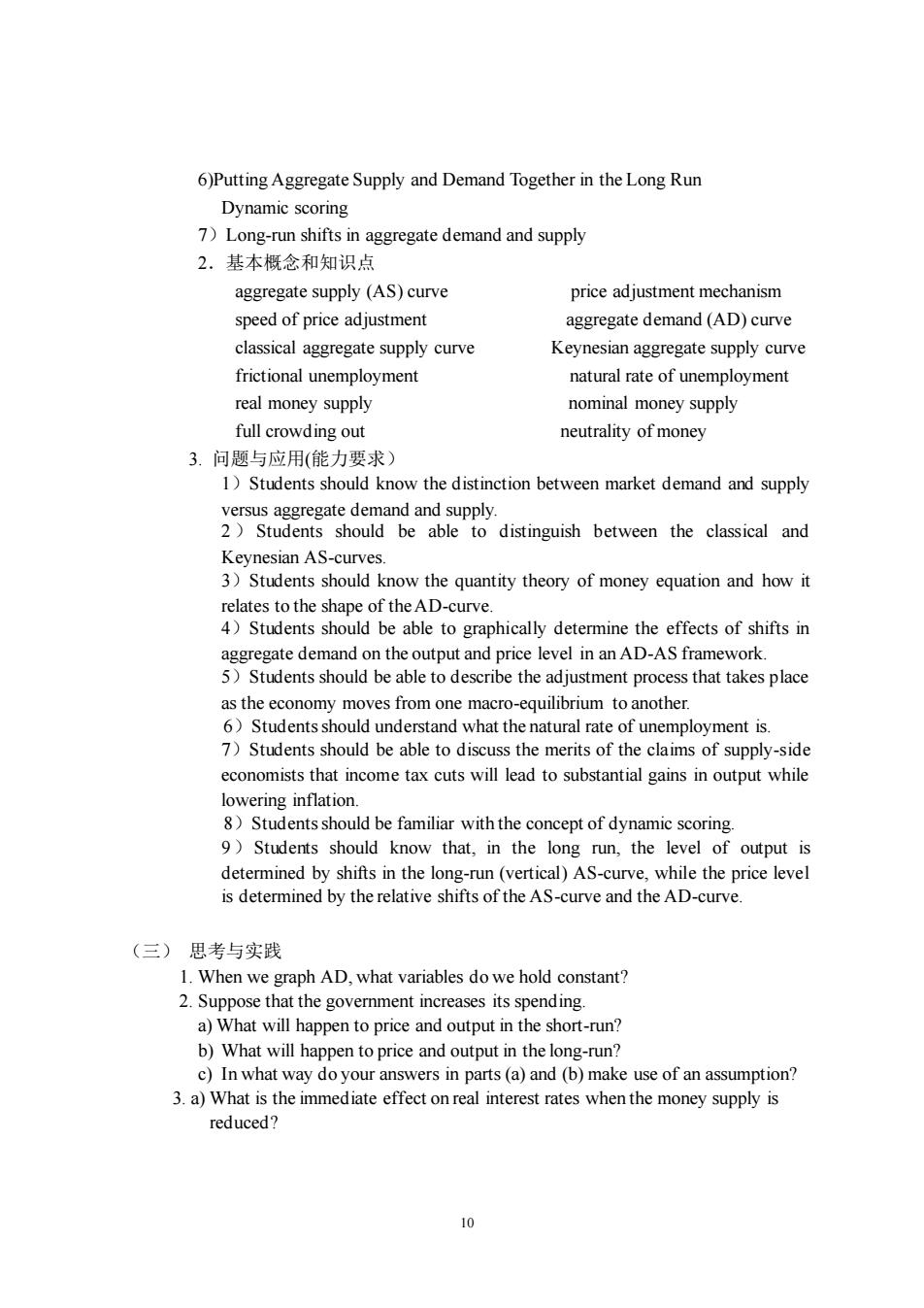正在加载图片...

6)Putting Aggregate Supply and Demand Together in the Long Run Dynamic scoring 7)Long-run shifts in aggregate demand and supply 2.基本概念和知识点 aggregate supply (AS)curve price adiustment mechanism speed of price adjustment aggregate demand(AD)curve classical aggregate supply curve Keynesian aggregate supply curve frictional unemployment natural rate of unemployment real money supply nominal money supply full crowding out neutrality of money 3.问题与应用(能力要求) 1Students should know the distinction between market demand and supply Keynesian AS-curves. 3)students should know the quantity theory of money equation and how it -curve nts shou able to graphically determine the effects of shifts in aggregate demand on the output and price level in an AD-AS framework. 5)Students should be able to describe the adjustment process that takes place as the economy moves from one macro-equilibrium to another 6)Students should unde tand what the oyment is. should be able to dis f the claims of supply-side economists that income tax cuts will lead to substantial gains in output while lowering inflation. 8)Students should be familiar with the concept of dynamic scoring. 9)Students should know that,in the long run,the level of output is ermined by shifts in the long-run(vertical)AS-curve ile the price level is determined by the relative shifts of the AS-curve and the AD-curve (三) 思考与实践 1.When we graph AD,what variables do we hold constant? 2.Suppose that the government increases its spending. a)What will happen to price and output in the short-run? b)What will happen to price and output in the long-rur c)In what way do your answers in parts(a)and(b)make use of an assumption? 3.a)What is the immediate effect on real interest rates when the money supply is reduced? 10 10 6)Putting Aggregate Supply and Demand Together in the Long Run Dynamic scoring 7)Long-run shifts in aggregate demand and supply 2.基本概念和知识点 aggregate supply (AS) curve price adjustment mechanism speed of price adjustment aggregate demand (AD) curve classical aggregate supply curve Keynesian aggregate supply curve frictional unemployment natural rate of unemployment real money supply nominal money supply full crowding out neutrality of money 3. 问题与应用(能力要求) 1)Students should know the distinction between market demand and supply versus aggregate demand and supply. 2 ) Students should be able to distinguish between the classical and Keynesian AS-curves. 3)Students should know the quantity theory of money equation and how it relates to the shape of the AD-curve. 4)Students should be able to graphically determine the effects of shifts in aggregate demand on the output and price level in an AD-AS framework. 5)Students should be able to describe the adjustment process that takes place as the economy moves from one macro-equilibrium to another. 6)Students should understand what the natural rate of unemployment is. 7)Students should be able to discuss the merits of the claims of supply-side economists that income tax cuts will lead to substantial gains in output while lowering inflation. 8)Students should be familiar with the concept of dynamic scoring. 9)Students should know that, in the long run, the level of output is determined by shifts in the long-run (vertical) AS-curve, while the price level is determined by the relative shifts of the AS-curve and the AD-curve. (三) 思考与实践 1. When we graph AD, what variables do we hold constant? 2. Suppose that the government increases its spending. a) What will happen to price and output in the short-run? b) What will happen to price and output in the long-run? c) In what way do your answers in parts (a) and (b) make use of an assumption? 3. a) What is the immediate effect on real interest rates when the money supply is reduced?